
Pipe Spring National Monument is a United States National Monument located in the U.S. state of Arizona, rich with American Indian, early explorer, and Mormon pioneer history. Administered by the National Park Service, Pipe Spring was listed on the National Register of Historic Places on October 15, 1966, and the boundaries of the Pipe Spring National Monument Historic District were expanded in October 2000.
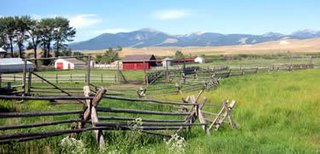
The Grant–Kohrs Ranch National Historic Site, created in 1972, commemorates the Western cattle industry from its 1850s inception through recent times. The original ranch was established in 1862 by a Canadian fur trader, Johnny Grant, at Cottonwood Creek, Montana, along the banks of the Clark Fork river. The ranch was later expanded by a cattle baron, Conrad Kohrs (1866–1920). The 1,618 acres (6.55 km2) historic site is maintained today as a working ranch by the National Park Service.
Johnny Lang was an American cattle driver who discovered Lost Horse Mine in Joshua Tree National Park. He claimed that he had moved to the area because his brother had been gunned down in New Mexico with six other cowboys. In 1890, in the process of herding their cattle, they lost their horses in what is now known as Lost Horse Valley. He tracked them to what is now known as Keys Desert Queen Ranch, which at that time was believed to be occupied by cattle rustlers from what known as the McHaney Gang, but did not find the horses. He then claimed he then met "Dutch" Frank, who claimed he discovered a rich gold claim but was afraid to develop it because he had been threatened by the purported rustlers. Lang and his father bought the rights to the mine, purportedly for $1,000.00, and named it "Lost Horse". He claimed to have taken on three partners as back-up, out of fear of the gang of purported rustlers or having his claim jumped. The four men filed their claim, set up a two-stamp mill and began to produce substantial amounts of gold. Lang's claim and mill were then sold to a Montana rancher named J.D. Ryan. Much of this history was provided by longtime Joshua Tree area resident William F. Keys, for whom Keys Ranch was named.

Barker Dam, also known as the Big Horn Dam, is a dam with water-storage reservoir located in Joshua Tree National Park in California. The dam was constructed by early cattlemen, including C. O. Barker, in 1900. It was raised in 1949 by rancher William F. Keys. It is situated between Queen Valley and the Wonderland of Rocks near the Wall Street Mill. It is a gathering place for desert wildlife, including many species of birds and desert bighorn sheep. Visitors can reach the dam via a short loop trail from a nearby parking lot off Barker Dam Road, and can see Native American petroglyphs a short distance to the west. There is also good bouldering on side trails near the dam. The park offers a Barker Dam Nature Hike led by a ranger.

Kentucky Camp is a ghost town and former mining camp along the Arizona Trail in Pima County, Arizona, United States, near the community of Sonoita. The Kentucky Camp Historic District is listed on the National Register of Historic Places and has been since 1995. As it is located within Coronado National Forest, the United States Forest Service is responsible for the upkeep of the remaining buildings within the Kentucky Camp Historic District.
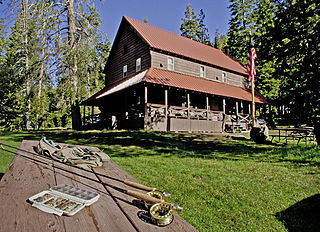
Drakesbad Guest Ranch, also known simply as Drakesbad, is a resort near Chester, California. It is located on Hot Springs Creek at the head of Warner Valley, in Lassen Volcanic National Park.

White Oaks was once a ghost town in Lincoln County, New Mexico, United States. Located on the outskirts of the Lincoln National Forest, it became a boomtown in 1879 following the discovery of gold and coal in the nearby Jicarilla Mountains.

Joshua Tree National Park is an American national park in southeastern California, east of Los Angeles and San Bernardino, near Palm Springs. It is named for the Joshua trees native to the Mojave Desert. Originally declared a national monument in 1936, Joshua Tree was redesignated as a national park in 1994 when the U.S. Congress passed the California Desert Protection Act. Encompassing a total of 790,636 acres – slightly larger than the state of Rhode Island – the park includes 429,690 acres of designated wilderness. Straddling San Bernardino and Riverside Counties, the park includes parts of two deserts, each an ecosystem whose characteristics are determined primarily by elevation: the higher Mojave Desert and the lower Colorado Desert. The Little San Bernardino Mountains traverse the southwest edge of the park.

The Desert Queen Mine in the Colorado Desert was one of the more long-lived gold mines of Southern California's high desert region. The abandoned mine is located in Riverside County, California within the boundaries of the Joshua Tree National Park and is included on the National Register of Historic Places. A hiking trail leads to the mine.

The Keys Ranch is the prime example of early settlement in the Joshua Tree National Park area. Bill Keys was the area's leading character, and his ranch is a symbol of the resourcefulness of early settlers. The ranch is an extensive complex of small frame buildings built between 1910 and Keys' death in 1969. Keys pursued both ranching and mining to make a living in the desert.
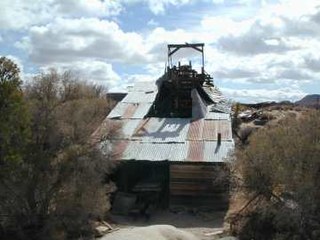
The Wall Street Mill in Joshua Tree National Park was a complete and operable gold ore crushing mill featuring late-19th century two-stamp mill machinery. Consequently, the significance encompasses the mill machinery, the building which houses it, the well which supplied water for the mill's operation, and the well pump. It is the only gold ore crushing mill in the region that retains integrity.
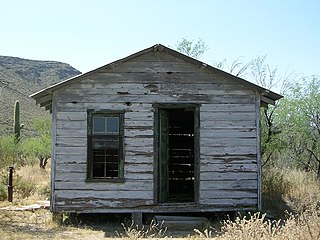
The Bates Well Ranch, also known as the Bates Well, Growler Well, Gray Ranch and El Veit, was one of the fifteen ranches and line camps in the Gray family cattle business in the Sonoran Desert country north of the US-Mexico border in Pima County, Arizona. Operating for nearly 60 years, the ranch is now part of Organ Pipe Cactus National Monument.

The Dos Lomitas Ranch, also known as the Rattlesnake Ranch, Blankenship Well and the Gray Ranch, was the first of fifteen ranches and line camps in the Gray family cattle business in the Sonoran Desert country north of the US-Mexico border in Arizona. The ranch is now part of Organ Pipe Cactus National Monument. The period of significance begins for the district with the purchase of the water rights for the ranch in 1919 and ends with the death with the last of the three Gray sons, Robert, Jr., in 1976, and the subsequent removal of the last of the Gray's cattle from the monument.

The McGraw Ranch, also known as the Indian Head Ranch, the =Y Ranch and the =X Ranch, was established in the Cow Creek valley near Estes Park, Colorado by Peter J. Pauley, Jr., who built a barn at his 160-acre (0.65 km2) =Y Ranch in 1884, running 2500 head of cattle on the land. The land was sold in 1897 to Hugo S. Miller, who worked with Henry C. Rouse to expand the property to a thousand acres (4 km²). In 1907 Miller and his wife inherited the lands from Rouse and were visited by Joh J. and Irene McGraw, who leased the property the next summer and purchased it in 1909, changing the brand to =X.

The P Ranch is a historic ranch in Harney County in southeastern Oregon, United States. The remaining ranch structures are located on the west bank of the Donner und Blitzen River in the Malheur National Wildlife Refuge. The ranch was built by Peter French, a well known 19th-century cattle baron. The P Ranch became headquarters for the French-Glenn Livestock Company, which eventually covered over 140,000 acres (570 km2). After French was murdered in 1897, the French-Glenn Livestock Company slowly sold off the P Ranch property. In 1935, the United States Government purchased the remaining P Ranch property to add to an adjacent wildlife refuge. The Civilian Conservation Corps demolished most of the original ranch buildings in the 1930s, and a fire destroyed the main ranch house in 1947. The few remaining P Ranch structures are now listed on the National Register of Historic Places.

The Sod House Ranch is an historic ranch in Harney County in southeastern Oregon, United States. The remaining ranch structures are located south of Malheur Lake in the Malheur National Wildlife Refuge. The ranch was built by Peter French, a well known 19th-century cattle baron. The Sod House Ranch became the headquarters for the northern operating division of the French-Glenn Livestock Company, which eventually covered over 140,000 acres (570 km2). After French was murdered in 1897, the French-Glenn Livestock Company slowly sold off its ranch property. In 1935, the United States Government purchased the Sod House Ranch property to add to an adjacent wildlife refuge. The eight remaining Sod House Ranch buildings are now listed on the National Register of Historic Places.

The historical buildings and structures of Grand Teton National Park include a variety of buildings and built remains that pre-date the establishment of Grand Teton National Park, together with facilities built by the National Park Service to serve park visitors. Many of these places and structures have been placed on the National Register of Historic Places. The pre-Park Service structures include homestead cabins from the earliest settlement of Jackson Hole, working ranches that once covered the valley floor, and dude ranches or guest ranches that catered to the tourist trade that grew up in the 1920s and 1930s, before the park was expanded to encompass nearly all of Jackson Hole. Many of these were incorporated into the park to serve as Park Service personnel housing, or were razed to restore the landscape to a natural appearance. Others continued to function as inholdings under a life estate in which their former owners could continue to use and occupy the property until their death. Other buildings, built in the mountains after the initial establishment of the park in 1929, or in the valley after the park was expanded in 1950, were built by the Park Service to serve park visitors, frequently employing the National Park Service Rustic style of design.
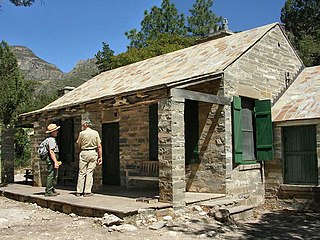
The Wallace Pratt Lodge was the summer residence of Wallace Pratt, the principal donor of the lands that would become Guadalupe Mountains National Park. Pratt was a petroleum geologist employed by the Humble Oil Company, scouting for oilfield leases in west Texas. Pratt visited the Guadalupe Mountains in 1921, and taking a liking to the place, he bought a quarter share of the McCombs Ranch. In 1929 Pratt bought out his partners, ending up owning a large portion of the canyon, which featured waterfalls flowing over travertine dams, a lush, quiet place in the high desert.


















